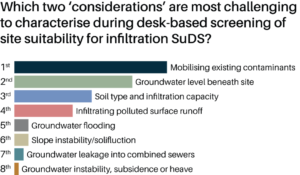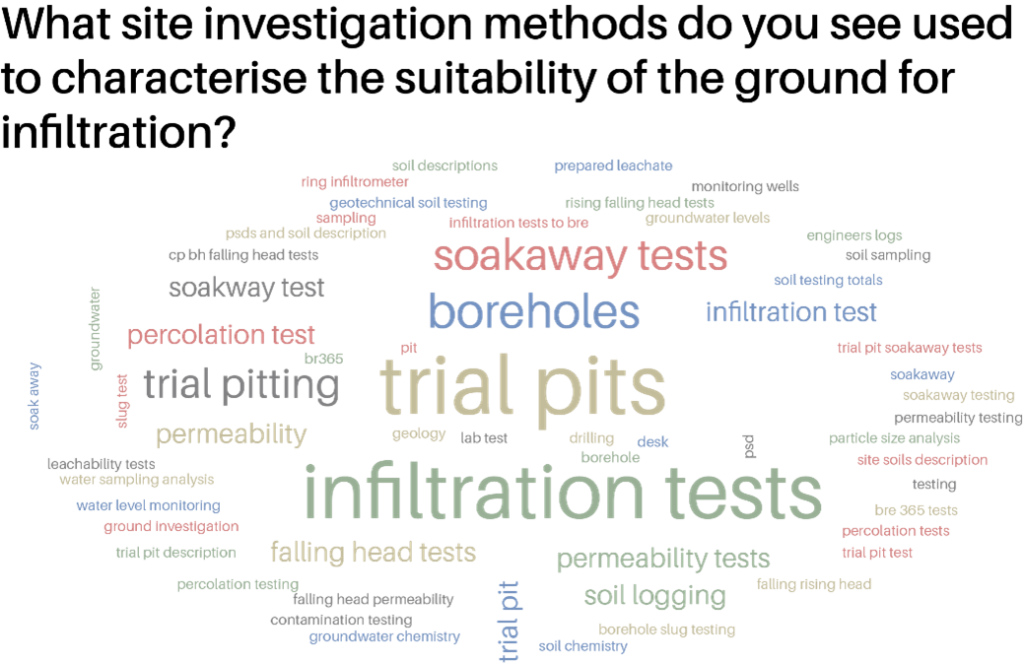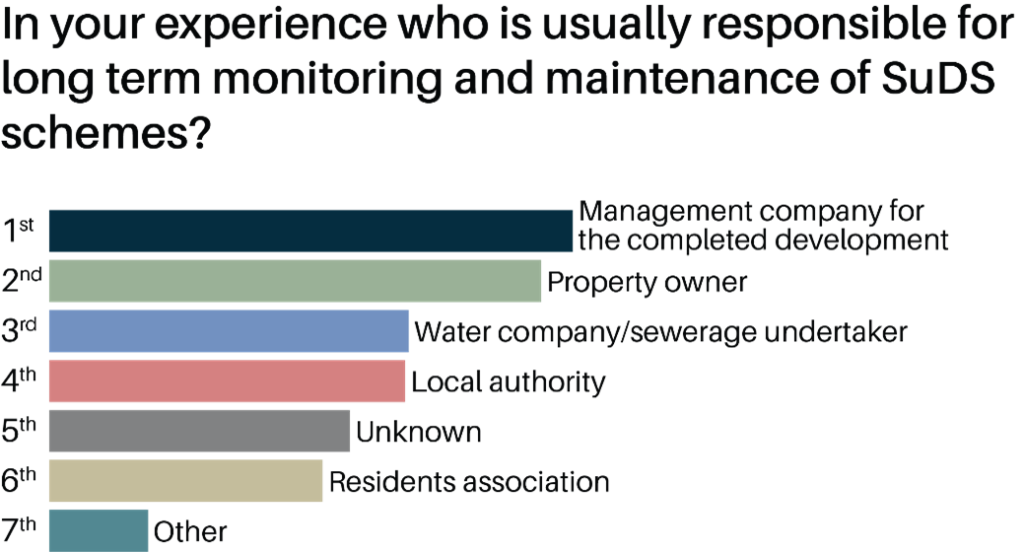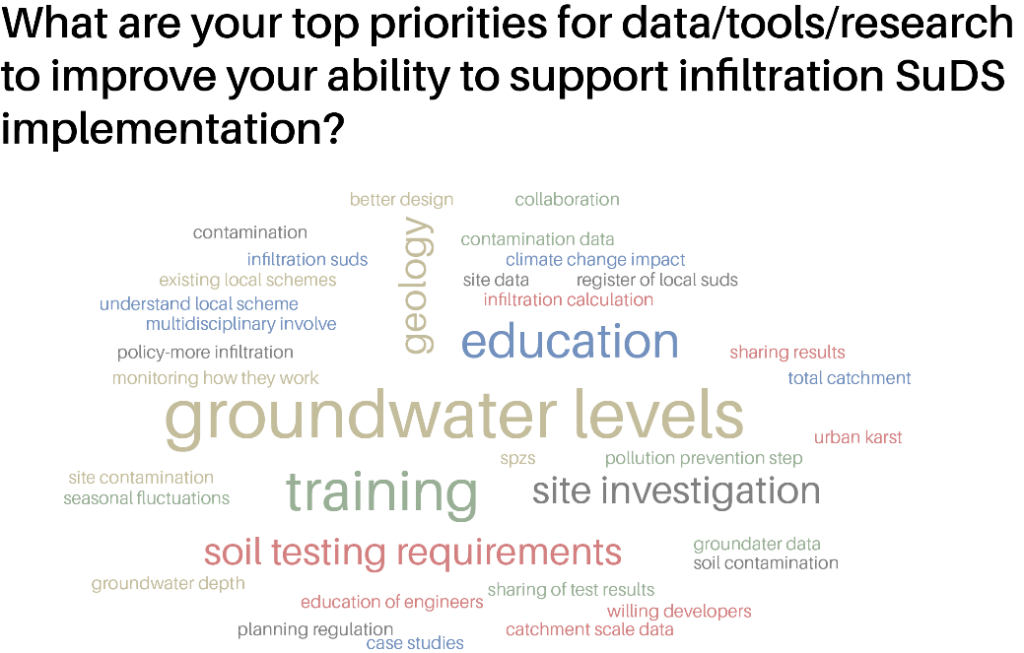What lies beneath? Using infiltration SuDS on potentially contaminated brownfield land
Darren Beriro and Chris Jackson, British Geological Survey
Urban infiltration
With predicted increases in the intensity of rainfall events under future climate, there is, of course, a need to reduce flood risk by ‘slowing the flow’. Source control measures, such as green roofs, rainwater harvesting, disconnecting downpipes, and more trees are needed, and might be considered the first priority when planning new SuDS for an urban area, but we’ll need all the SuDS ‘tools’ in the ‘toolbox’.
Infiltration SuDS are appealing as they reduce runoff into the surface drainage network, but characterising their potential, and associated risks, is often difficult because of limited knowledge about the subsurface. This will not be a surprise to SuDS professionals, nor to hydrogeologists who know that urban recharge remains an active area of research; see this nice case study, for example, on the impact of urbanisation on groundwater recharge for a Swiss city – both runoff and infiltration went up as the city urbanised.
So, urban infiltration is complicated, but what is needed to practically support the wider implementation of infiltration SuDS, which can be an important part of sustainable water management for both new and existing developments? Can a wider use of infiltration SuDS on brownfield land be possible? This is what we sought to explore through an Environment Analyst virtual knowledge exchange event on the topic of infiltration SuDS. The event was hosted by the British Geological Survey (BGS), consisting of four talks from experienced SuDS professionals, and a short survey to gather some information from attendees.
SuDS on brownfield sites
Is it possible to implement infiltration SuDS on brownfield sites? Steve Wilson from the Environmental Protection Group says: “yes, but a good understanding of geological and contamination conditions is required and the conceptual site model is the most important part of any infiltration design”. Often a ‘source-pathway-receptor’ conceptual modelling approach is taken, but alone, this is not really suitable when considering how contamination might influence infiltration systems”. Steve added, “rather, we should be aiming for much more in-depth and robust understanding of how a site works, based on:
- a ground model;
- a hydrogeological model including understanding of how groundwater levels vary spatially and in time; and
- knowledge of contamination distributions across the site.”
Conceptual models should be diagrammatic, and preferably, based on cross-sections which include a representation of infiltration devices. Ideally we should be aiming for 3D conceptualisation. BS EN ISO 21365, published in June 2020, is a good guide for how to produce conceptual models on contaminated sites, and supports both site investigation and design of infiltration devices.
Desk-based screening
Regarding conceptual model development, we asked our audience “which two [SuDS Manual] ‘considerations’ are most challenging to characterise during desk-based screening of site suitability for infiltration SuDS?” The spread of answers are shown in the first figure below.

Contamination was seen as the top challenge and given the high level of subject matter expertise required here, it is perhaps no surprise.
Characterising groundwater levels beneath a site is the second on the list, and is predominantly related to the paucity of available data at the ‘local’ scale. This problem will be difficult to solve but could be improved if innovations to collate, manage and deliver shallow groundwater level data, particularly in urban areas, can be made, perhaps through the use of citizen science.
SuDS in site investigation
There was agreement by the professionals on the panel that site investigation often under-serves the drainage design process, and that desk studies and site investigation are typically under-valued and under-priced.
Russell Bowman from Soil and Structures said “With a focus on contaminated land within the planning process for brownfield sites, other considerations are often secondary. For example, a site characterised as having ‘low permeability soils’, often puts an end to the consideration of infiltration SuDS as a viable option”. Russell called for “a more considered phased approach based on:
- information gathering as part of a desk study developing ground and hydrogeological conceptual models;
- limited intrusive site investigation;
- detailed site investigation including targeted investigations as site plans develop; and
- collation of information and appraisal continuing into the construction works.”
We also asked the audience what site investigation methods are used most to characterise a site. The answers are summarised as word cloud in the second figure below.

The word cloud shows that a reliance on a range of site investigation methods where trial pits and various types of infiltration tests dominate. An important point that came out of the discussion was “not to rely on the BRE 365 test alone” and agreement that “the conceptual model for the site and scenario is crucial”.
Catchment scale impacts
Issues about the wider catchment-scale effect of SuDS were also discussed. SuDS may have important impacts across multiple administrative boundaries, and a wider catchment and cross-catchment view is needed to develop policies that will deliver high quality SuDS.
Hannah Fraser from H Fraser Consulting shaped this conversation, saying “knowledge about how multiple small-scale SuDS interventions will affect catchment hydrological response is limited, and higher resolution monitoring of catchments is needed to understand local causes of catchment-wide effects. This is also true of wider natural flood management measures, and is a current active area of research.”
Hannah added “Proper frameworks for the management and maintenance of SuDS are also needed. We know that without legislation, funding to maintain a new SuDS must be resolved in the early stages of the development process”, which related to the final question we asked our audience, who do you see being responsible for the long-term monitoring and maintenance of SuDS.
Who is responsible?
The answer to this question indicates that SuDS are most often monitored and maintained by the developer or site owner. This is probably as expected, considering that other large surveys about SuDS maintenance and adoption have shown that uncertainty around maintenance presents barriers to adoption.

Infiltration SuDS – the latest
The final presentation focussed on findings of research at an infiltration SuDS observatory. Rachel Bell from BGS reported “where permeable pavement was found transfer rainfall rapidly to the aquifer below, and faster than over the surrounding grassed area where soil compaction caused a more delayed response.” The fourth figure below summarises answers to the final survey question about what information or research is required to enhance support for infiltration SuDS implementation. The answers are broad, though a number touch on the theme of training, knowledge exchange and sharing of data. The lack of data on groundwater levels is a key issue.

Conclusions
The workshop aimed to contribute to a better shared understanding of the data, information and knowledge required to support infiltration SuDS scheme design and implementation. Conclusions were that:
- Infiltration SuDS are an important part of sustainable water management for current and future developments;
- Incorporation of infiltration SuDS into brownfield projects poses risks to water quality not usually present for other types of land. However, with the right assessment and judgement, infiltration can be used at sites with variable ground quality; and
- The decision-making process for infiltration SuDS requires a carefully considered ground model, quality data and information to support scheme design and implementation and an appreciation of the long-term durability of the engineering solutions installed at both localised and catchment scales.
The event was an enjoyable learning experience for the hosts, our speakers and hopefully for the 90 or so participants. Were the questions and answers addressed during the workshop definitive? Certainly not, but they were clear about the central role of:
- Robust conceptual models that cover contamination, hydrogeology and geotechnical aspects of the ground;
- Tailored site investigation; and
- A wider appreciation of regional hydrogeology and infiltration system design and its efficacy.
Reflecting on what we learned from the workshop, we are now curious to know: what role do SuDS play in in the wider domain of future water management and perhaps the re-emergence of the idea of ‘water neutral’ (re)development of our urban areas? Some progress is being made in this area with impact projects such as ‘community water management for a liveable London’ (CAMELLIA).
The authors would really welcome thoughts or comments on this question or indeed any other aspect of our findings.
Note: This blog is based on discussions from the Environment Analyst virtual workshop “Exploring the Barriers and Opportunities for Infiltration SuDS on Potentially Contaminated Brownfield Land”, 25/11/2020, and the presentations from the speakers:
- Infiltration SuDS on brownfield sites. Steve Wilson, The Environmental Protection Group Ltd.
- Building a hydrogeological conceptual model for SuDS design, Hannah Fraser, H Fraser Consulting Ltd
- The role of site investigation to provide quality data and information for SuDS design engineers. Russell Bowman, Soils and Structures Ltd.
- BGS infiltration SuDS observatory: learnings and challenges. Rachel Bell, British Geological Survey.
Darren Beriro is a Senior Geoscientist at BGS where he leads on data-driven brownfield land research and innovation, for example, the development of the Brownfield Ground Risk Calculator.
Chris Jackson is a Principal Hydrogeologist and Groundwater Modeller at BGS where he leads the environmental modelling research group.
Steve Wilson is a civil/ geotechnical engineer and Technical Director at The Environmental Protection Group Ltd. He is co-author of CIRIA’s guidance on the construction of SuDS, and of The SuDS Manual.
Hannah Fraser is a hydrogeologist and Director of H Fraser Consulting Ltd. She is the lead author of CIRIA’s guide to small brownfield sites and land contamination.
Russell Bowman is an engineer and Director of Soil and Structures Ltd. He is lead author of CIRIA’s guide on unexploded ordnance risk.
Rachel Bell is a hydrogeologist at the British Geological Survey, where she has led research and monitoring programmes to investigate infiltration SuDS performance.
Contact with each of our contributors can be made using social media platforms or through their own organisational websites.
Tags: Blue-Green Infrastructure, Brownfield, SuDS